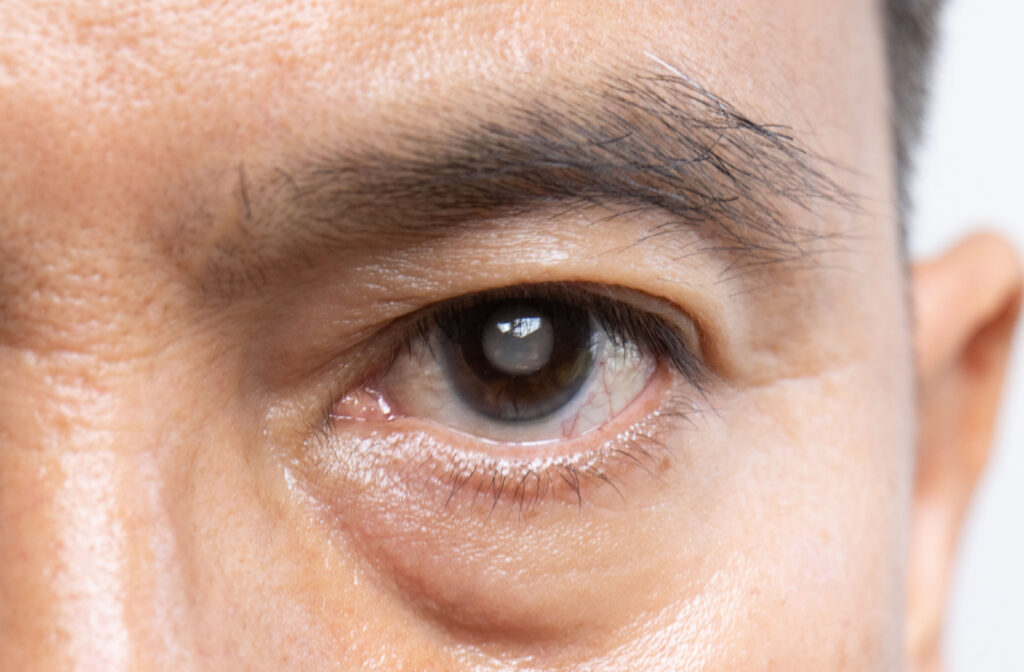Cataracts and glaucoma are 2 common eye diseases that can damage your vision. These conditions can develop slowly, and eventually lead to vision loss. While cataracts and glaucoma both affect your vision, they are distinct conditions.
Cataracts and glaucoma differ in many ways—they affect different parts of the eye, have separate causes, and the treatments have different outcomes. Surgery can help restore lost vision from cataracts, while glaucoma treatments can only preserve your remaining vision.
What Are Cataracts?
Cataracts are a common eye condition occurring when the eye’s lens becomes cloudy, causing blurred or hazy vision. They can develop slowly over time, and symptoms may not be noticeable at first.
While cataracts can occur at any age, they are most common in older adults. Other risk factors for this condition include diabetes, smoking, and long-term exposure to UV radiation.
Common cataract symptoms include:
- Blurry or cloudy vision
- Poor night vision
- Halos appearing around lights
- Light sensitivity
- Faded colours
- Frequent prescription changes
While cataracts might be manageable at first, they can worsen with time until severe vision loss occurs.
What Causes Cataracts?
The primary cause of cataracts is aging. Your eye’s lens is typically clear and flexible, easily changing shape to help you see. Around 40, the eye’s lens has natural changes that can lead to cataracts.
The proteins in the lens begin to break down, clumping together. The clumping of these proteins creates cloudy areas that become a cataract. While cloudiness in the lens may be mild at first, it can worsen with time and significantly affect your vision.
What Is Glaucoma?
Glaucoma is an eye condition that can lead to severe, permanent vision loss. It involves damage to the optic nerve, an essential part of your eye for processing vision. Many but not all forms of glaucoma raise your intraocular pressure (IOP), which your optometrist measures during your eye exam.
There are several types of glaucoma, including:
- Open-angle glaucoma: Open-angle glaucoma is the most common form of this disease. It occurs when fluid builds in the eye due to poor drainage, raising pressure in the eye affecting the optic nerve.
- Angle-closure glaucoma: Angle-closure glaucoma occurs when the space between your iris and cornea is too narrow, causing fluid to build in this area. In some cases, angle-closure glaucoma can develop quickly into an emergency with the potential for rapid vision loss.
- Normal tension glaucoma: Normal-tension glaucoma causes damage to the optic nerve without raising intraocular pressure, possibly due to an existing fragility in the eye structures.
While glaucoma can place your vision at risk, early detection and treatment can help protect your sight.
What Causes Glaucoma?
Glaucoma typically occurs due to fluid buildup in the eye, depending on the type of glaucoma. Fluid may struggle to drain from the eye effectively or your iris may block fluid. When fluid gets trapped, eye pressure rises and damages the optic nerve.
Damage to the optic nerve from increased eye pressure can lead to vision loss or blindness. Other factors that can contribute to the development of glaucoma include genetics, age, and certain medical conditions such as diabetes.
What’s the Difference Between Cataracts & Glaucoma?
There are 2 main differences between cataracts and glaucoma: their cause and treatment.
Cataracts develop when proteins break down inside the lens, creating cloudy areas that worsen with time. Glaucoma typically occurs due to fluid build-up in the eye, which increases eye pressure and damages the optic nerve.
Treating cataracts can help improve your vision—your optometrist can refer you for cataract surgery, which replaces the eye’s natural lens with an artificial lens. Glaucoma treatment can involve surgery, medication, or laser treatment. While treatment can help manage glaucoma, it can’t help restore lost vision.

How Can You Treat Cataracts?
Stronger prescriptions and eye surgery can help treat cataracts. A stronger prescription may help you see more clearly in the early stages of cataracts. However, as cataracts progress, surgery may be necessary to remove the cloudy lens and replace it with an artificial one.
This procedure is generally safe and effective, with most people experiencing a significant improvement in their vision afterwards.
How Can You Treat Glaucoma?
The ideal treatment for glaucoma depends on the type you have. Your eye doctor can help determine the best treatment for your needs after assessing your eyes in an eye exam.
Common glaucoma treatments include:
- Medication: Medications are commonly prescribed to help patients with glaucoma lower their eye pressure.
- Laser treatment: Your eye doctor may recommend laser treatment to help fluid better drain from the eyes.
- Surgery: Surgery may be recommended when other treatments cannot help. Many glaucoma surgeries exist, and all are designed to help fluid more efficiently drain from the eye, lowering pressure.
Take Care of Your Eye Health & Vision
Eye diseases like cataracts and glaucoma can damage your vision, but your optometrist is here to help. Regular eye exams are necessary to help diagnose these conditions as early as possible.
Contact the eye doctors at Pinnacle Eyecare if you experience symptoms of cataracts or glaucoma. These conditions need treatment to help protect your sight.





